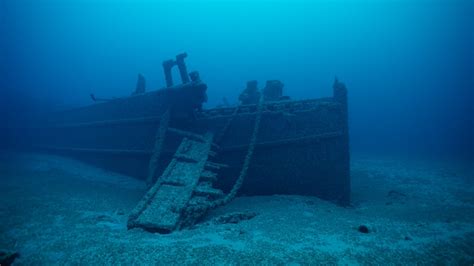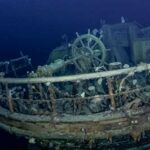
A remarkably well-preserved shipwreck, believed to be the largest ever discovered of its kind, has been found off the coast of France by archaeologists conducting unrelated research. The vessel, a cargo ship dating back to the late 16th or early 17th century, was discovered unexpectedly while scientists were mapping the seabed for geological surveys. Its exceptional state of preservation offers a rare glimpse into maritime trade and shipbuilding techniques of the era.
The discovery, announced this week by the French Ministry of Culture, occurred during a routine sonar survey intended to map geological features on the seafloor. Instead, the sonar picked up the distinct outline of a large, intact shipwreck. Intrigued, a team of marine archaeologists was dispatched to investigate, quickly determining the site’s significance.
“It’s an extraordinary discovery,” said Dr. Marine Dubois, the lead archaeologist on the project, in a statement released by the Ministry. “The ship is incredibly well-preserved, and the size is unprecedented for this period. We believe it was a large cargo vessel, likely involved in international trade.”
The shipwreck lies at a depth of approximately 100 meters (330 feet), which has contributed to its preservation by minimizing wave action and human interference. Preliminary investigations suggest the ship was approximately 30 meters (98 feet) long and 8 meters (26 feet) wide, significantly larger than most ships from that era that have been previously discovered. The relatively deep location and the lack of immediate threats from looting or environmental damage allow archaeologists to carefully plan and execute the investigation.
Initial surveys of the site have revealed a wealth of artifacts both inside and around the vessel. These include cannons, anchors, ceramics, and what appears to be a large quantity of raw materials such as metal ingots. The diversity of cargo suggests the ship may have been involved in a variety of trade routes, transporting goods between different regions of Europe and potentially even further afield.
“The cargo is incredibly diverse, suggesting the ship was a major player in the trade networks of the time,” Dr. Dubois explained. “We’ve found evidence of materials from different parts of Europe, which indicates the ship was involved in long-distance trade routes.”
The French Ministry of Culture has emphasized the importance of this discovery and has committed to providing the resources necessary for a thorough investigation. The site has been designated as a protected area, and measures are being taken to prevent unauthorized access. The excavation and study of the shipwreck are expected to take several years, involving a team of experts in marine archaeology, conservation, and maritime history.
“This shipwreck represents a unique opportunity to learn about maritime trade and shipbuilding in the early modern period,” said Culture Minister Roselyne Bachelot in a press conference. “The government is fully committed to supporting this project and ensuring that the findings are shared with the public.”
The discovery of the shipwreck comes at a time of increasing interest in maritime archaeology and the study of submerged cultural heritage. Technological advances in sonar, underwater robotics, and diving equipment have made it possible to explore deeper and more remote underwater sites, leading to a surge in discoveries in recent years. The French coast, with its rich maritime history, has been a particularly fruitful area for archaeological research.
The ongoing investigation will focus on several key areas. First, archaeologists will carefully document the ship’s structure and layout, creating detailed plans and 3D models. This will provide valuable insights into the ship’s design and construction techniques. Second, the artifacts recovered from the site will be analyzed to determine their origin, age, and function. This will shed light on the ship’s cargo and trade routes. Third, the environmental context of the shipwreck will be studied to understand the conditions that led to its preservation and the factors that may threaten its long-term survival.
The discovery is already generating considerable excitement within the archaeological community. Experts believe that the shipwreck has the potential to rewrite our understanding of maritime history and provide new insights into the economic and social life of the early modern period. The sheer size of the vessel, coupled with the excellent preservation, makes it a truly unique and valuable find.
In-Depth Analysis and Background Information
To fully appreciate the significance of this discovery, it is essential to understand the context of maritime trade and shipbuilding during the late 16th and early 17th centuries. This period, often referred to as the Age of Exploration, witnessed a dramatic expansion of international trade, driven by the discovery of new lands and the establishment of colonial empires. European powers, including France, Spain, England, and the Netherlands, competed fiercely for control of trade routes and access to valuable resources.
Maritime trade was the lifeblood of these empires, facilitating the exchange of goods between Europe, Asia, Africa, and the Americas. Ships were the primary means of transportation, carrying everything from precious metals and spices to textiles, timber, and manufactured goods. The demand for larger and more efficient ships led to significant advances in shipbuilding technology, with shipwrights experimenting with new designs and materials.
The ship discovered off the coast of France appears to be a prime example of these innovations. Its size suggests that it was capable of carrying large quantities of cargo over long distances, making it a valuable asset in the competitive world of international trade. The presence of cannons indicates that the ship was also armed, likely to protect itself from pirates and rival powers.
The discovery of a shipwreck of this size and age is particularly rare. Most shipwrecks are heavily damaged by storms, currents, and marine organisms, making it difficult to reconstruct their original appearance. The exceptional preservation of this vessel is likely due to a combination of factors, including the depth of the water, the type of seabed, and the lack of strong currents. The relative absence of human interference has also played a crucial role in preserving the site.
The artifacts recovered from the shipwreck provide valuable clues about the ship’s origin, cargo, and destination. The ceramics, for example, can be analyzed to determine their place of manufacture, which can help to pinpoint the ship’s home port. The metal ingots can be identified by their composition, which can reveal the source of the raw materials. The presence of specific types of cargo can also indicate the ship’s intended destination and the goods it was meant to trade.
The analysis of the ship’s structure can provide insights into shipbuilding techniques of the period. By studying the ship’s design, construction materials, and joinery methods, archaeologists can learn about the skills and knowledge of the shipwrights who built it. This information can be compared to historical records and other archaeological finds to gain a better understanding of the evolution of shipbuilding technology.
The environmental context of the shipwreck is also an important area of study. The seabed around the ship can be analyzed to determine the types of marine organisms that have colonized the site and the extent to which they have affected the ship’s preservation. The currents, tides, and sediment composition can also be studied to understand the factors that have contributed to the site’s stability.
The ongoing investigation of the shipwreck is expected to yield a wealth of new information about maritime trade, shipbuilding, and the economic and social life of the early modern period. The findings will be shared with the public through publications, exhibitions, and online resources. The project also offers opportunities for collaboration between archaeologists, historians, conservators, and other experts, fostering a deeper understanding of our shared maritime heritage.
Expanded Context and Future Research
The discovery of this shipwreck contributes significantly to the broader field of maritime archaeology, which has seen remarkable advancements in recent decades. Technological developments have been pivotal in this progress, allowing researchers to explore deeper and more challenging underwater environments.
Advanced sonar systems, like the one that initially detected the shipwreck, can create detailed maps of the seabed, revealing the presence of submerged structures and artifacts. Remotely operated vehicles (ROVs) equipped with cameras and manipulators can be deployed to inspect and document underwater sites without the need for human divers. These ROVs can also collect samples of artifacts and sediment for analysis.
Diving technology has also improved significantly, allowing divers to work at greater depths and for longer periods. Rebreather systems, for example, recycle the diver’s exhaled air, reducing the risk of decompression sickness and extending underwater working time. Underwater communication systems allow divers to communicate with researchers on the surface, facilitating real-time collaboration and data collection.
The combination of these technologies has opened up new possibilities for maritime archaeological research, leading to a surge in discoveries around the world. Shipwrecks, submerged settlements, and other underwater cultural heritage sites are being identified and studied with increasing frequency.
The French coast, with its long and rich maritime history, is a particularly promising area for archaeological research. The country has a strong tradition of maritime archaeology, with a dedicated team of researchers and conservators working to protect and study its submerged cultural heritage. The discovery of this shipwreck is a testament to the success of these efforts.
Looking ahead, the ongoing investigation of the shipwreck will focus on several key areas. One priority is to carefully document the ship’s structure and layout, creating detailed plans and 3D models. This will provide valuable insights into the ship’s design and construction techniques. The use of photogrammetry, a technique that creates 3D models from photographs, will be crucial in this effort.
Another priority is to analyze the artifacts recovered from the site to determine their origin, age, and function. This will involve a range of scientific techniques, including X-ray fluorescence, mass spectrometry, and microscopic analysis. The results of these analyses will be compared to historical records and other archaeological finds to gain a better understanding of the ship’s cargo and trade routes.
The environmental context of the shipwreck will also be studied in detail. This will involve analyzing the seabed sediments, identifying the types of marine organisms that have colonized the site, and monitoring the currents and tides. The goal is to understand the factors that have contributed to the ship’s preservation and to identify any potential threats to its long-term survival.
The investigation will also involve collaboration with experts from other disciplines, including historians, conservators, and maritime engineers. Historians will help to interpret the historical context of the shipwreck, providing insights into the political, economic, and social conditions of the time. Conservators will work to stabilize and preserve the artifacts recovered from the site, ensuring that they can be studied and displayed for future generations. Maritime engineers will provide expertise on shipbuilding techniques and the structural integrity of the ship.
The results of the investigation will be shared with the public through a variety of channels, including publications, exhibitions, and online resources. The French Ministry of Culture is committed to making the findings accessible to a wide audience, fostering a greater appreciation of maritime history and the importance of preserving our submerged cultural heritage. The possibility of creating a virtual reality experience, allowing users to explore the shipwreck from the comfort of their own homes, is also being considered.
The discovery of this shipwreck is a reminder of the vast amount of undiscovered cultural heritage that lies beneath the sea. As technology continues to advance, it is likely that many more such discoveries will be made in the years to come. These discoveries have the potential to transform our understanding of the past and to provide valuable insights into the human experience. It underscores the importance of continued investment in maritime archaeological research and the protection of our submerged cultural heritage.
Frequently Asked Questions (FAQ)
Q1: Where was the shipwreck found and how deep is it?
A1: The shipwreck was found off the coast of France. It lies at a depth of approximately 100 meters (330 feet).
Q2: How old is the shipwreck believed to be?
A2: The shipwreck is believed to date back to the late 16th or early 17th century.
Q3: What type of ship was it and what was it carrying?
A3: Preliminary investigations suggest the ship was a large cargo vessel, likely involved in international trade. The cargo appears to be diverse, including cannons, anchors, ceramics, and raw materials such as metal ingots. “The cargo is incredibly diverse, suggesting the ship was a major player in the trade networks of the time,” said Dr. Dubois. “We’ve found evidence of materials from different parts of Europe, which indicates the ship was involved in long-distance trade routes.”
Q4: How was the shipwreck discovered?
A4: The shipwreck was discovered accidentally during a routine sonar survey intended to map geological features on the seafloor.
Q5: What are the plans for investigating and preserving the shipwreck?
A5: The French Ministry of Culture has designated the site as a protected area and is taking measures to prevent unauthorized access. The excavation and study of the shipwreck are expected to take several years, involving a team of experts in marine archaeology, conservation, and maritime history. Archaeologists will carefully document the ship’s structure, analyze the recovered artifacts, and study the environmental context of the shipwreck. The findings will be shared with the public through publications, exhibitions, and online resources. Culture Minister Roselyne Bachelot stated, “This shipwreck represents a unique opportunity to learn about maritime trade and shipbuilding in the early modern period. The government is fully committed to supporting this project and ensuring that the findings are shared with the public.”









